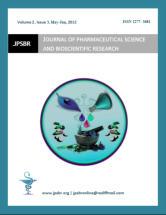





ISSN 2277 - 3681
Volume 3, Issue 3
Pages no. 100-121

Liponiosomal Drug Delivery System - A Review
Ashish Tripathi*, Dr. R.P.S Rathore, Dr. C.S Chauhan, Dharmendra sisodiya






Determination of Sodium and Potassium Content Present in Water Sample Collected from Girna and
Godavari River by Flamephotometry
Amrutkar R. D.*, Thube A.E., Kulkarni S. C.,





Development and Validation of UV Spectroscopic and RP-HPLC method for Simultaneous Estimation of Levosulpiride
and Rabeprazole Sodium in bulk and tablet dosage form
Divya G. Thakkar*





LC-NMR: A powerful tool for analyzing and characterizing complex chemical mixtures without the need of
chemical separation
Bhumika. D. Sakhreliya*, Swati Kansara





© JPSBR Publications 2011-2024
Powered by Opus
ABSTRACT:
Liponiosomes
represent
a
promising
drug
delivery
module.
They
present
a
structure
similar
to
liposome
and
noisome.
Hence
they
can
represent
alternative
vesicular
systems
with
respect
to
liposomes,
and
niosomes
due
to
the
liponiosome
ability
to
encapsulate
different
type
of
drugs
within
their
multi
environmental
structure.
Liponiosomes
are
thoughts
to
be
better
candidate’s
drug
delivery
as
compared
to
liposomes
and
niosomes
due
to
various
factors
like
cost,
stability
and
wide
range
of
drug
delivery
etc.
Various
types
of
drug
deliveries can be possible using liponiosomes like targeting, ophthalmic, topical, parentral, etc.
Keyword:
Liponiosomes, Liposome, noisome, Targeting, Ophthalmic, Topical, Parentral
.
ABSTRACT:
Flame photometry (more accurately called flame atomic emission spectrometry) is a branch of atomic
spectroscopy in which the species examined in the spectrometer are in the form of atoms. Flame photometry is
suitable for qualitative and quantitative determination of several cations, especially for metals that are easily
excited to higher energy levels at a relatively low flame temperature (mainly Na, K, Rb, Cs, Ca, Ba, Cu).
The major
cation of the extracellular fluid is sodium and intracellular cation found to be potassium. When the concentration
level of the sodium cation in the human plasma decreases leads to cause Hyponatraemia and hypernatraemia
when the level is raised. In case of potassium cation hypokalaemia (lowered plasma [K
+
]), hyperkalaemia (increased
plasma [K
+
]) and hyperkaluria (increased urinary excretion of K
+
) The present article include the Comparative
studies on
Sodium and Potassium content Present in Water Sample Collected from Girna
in Malegaon
and
Godavari ( Nasik) River.
Key Words
:
Flame photometry, Sodium, Potassium.

ABSTRACT:
Three simple, rapid, accurate, precise and cost-effective UV spectrophotometric methods and RP – HPLC have been
developed and validated for simultaneous estimation of Levosulpiride and Rabeprazole Sodium in tablet dosage
form. Method I is estimation using simultaneous equation method at 232 nm (λmax of Levosulpiride) and 284 nm
(λmax of Rabeprazole Sodium). Method II is 1
st
order derivative method utilize absorbance measurement at 247
nm for Levosulpiride and 291.60 nm for Rabeprazole Sodium. Method III is RP-HPLC method for simultaneous
estimation of Levosulpiride and Rabeprazole Sodium separation was achieved on a Phenomenexluna ODS C18
(250mm X 4.6 mm i.d., 5 μm particle size) with an mobile phase acetonitrile: 50 mM phosphate buffer pH 5
(adjusted with Sodium hydroxide) in the ratio of 55:45 v/v. The mobile phase at a flow rate of 1.0 ml/min, Injection
volume 20μl and detection wavelength was kept at 288 nm. The retention time Levosulpiride and Rabeprazole
Sodium was 2.31±0.1min and 3.85 ±0.1min, respectively. The linearity lies between 5-30 μg/ml for Levosulpiride
and 2-12 μg/ml for Rabeprazole Sodium.The proposed conditions were successfully applied for the simultaneous
estimation of both drugs in commercial tablet preparation and were validated according to ICH guidelines.
KEYWORDS:
Levosulpiride, Rabeprazole Sodium, UV spectrophotometry, Simultaneous equation method, Derivative method,
RP-HPLC.

ABSTRACT:
The on-line coupling of high-performance liquid chromatography (HPLC) principles to high-resolution NMR
spectrometers offers a powerful tool for analyzing and characterizing complex chemical mixtures without the need
of chemical separation. LC-NMR promises to be of great value in the analysis of complex mixtures of all types,
particularly the analysis of natural products and drug-related metabolites in biofluids. However, the advantages of
directly coupling NMR and HPLC instrumentation must be weighed against compromises in performance made to
each technique to achieve a hyphenated system. While significant advances have been made in LC-NMR
technology, a strong case can be made that HPLC purification of metabolites followed by conventional tube NMR is
equally useful.
KEYWORDS:
LC-NMR, instrumentation, hyphenated system













































































